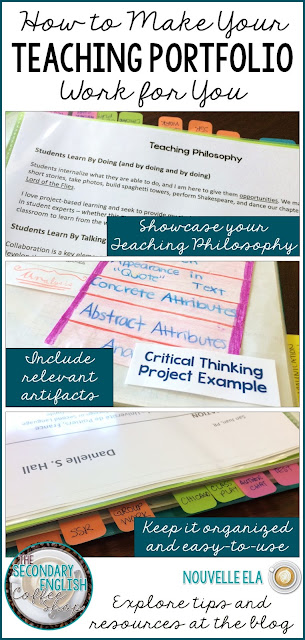Hey, y’all! This is Danielle from Nouvelle ELA, taking over the Coffee Shop this week to get real about Teaching Portfolios. Whether it’s to prepare for an annual review, to look for a new job, or just to feel great about what an amazing teacher you are, you need a Teaching Portfolio.
I’m a military spouse and we are early in our career,
meaning that we move around a LOT. I’ve already had to interview for several
teaching positions, and I can tell you that a stellar Teaching Portfolio has
won me more than one job. It has also helped me move up a level on a couple of
components in my annual review – I had the proof that I was accomplished in the
target area! All of the examples in this post are from my teaching portfolio,
and be sure to check out the free planning sheet.
So, let’s break it down.
A great Teaching Portfolio:
*showcases you and your teaching philosophy
*includes artifacts (photos, student samples, lesson
plans) that support those philosophies
*is organized and useful in a job interview or annual
review.
1. A Teaching Portfolio should showcase your philosophy.
The whole point of a Teaching Portfolio is so that the
person sitting across from you can get a glimpse into your wonderful expert
teacher brain and imagine a day in the life of your classroom. Is your
classroom quiet or loud? Do you favor lectures or group work? Do you give a lot
of direct feedback, or do you favor peer editing? What is your main strategy
for developing strong readers?
Your whole Teaching Portfolio is really centered around
this philosophy, so be sure to check out this Teaching Philosophy Questionnaire and Teaching Portfolio Checklist to get started.
2. A Teaching Portfolio should include a lot of proof.
This is the most fun aspect of a portfolio, in my
opinion: collecting artifacts. For the next month, snap a picture at least once
a day of life in your classroom. This can be students working on activities,
bulletin boards and displays, and student work. Keep student samples if you
can, but be sure to take pictures of three-dimensional projects, too.
In addition to proof of your life with students, snag
proof of other parts of your school life, too. Print a few emails to parents to
show your communication style. HUGE CAVEAT here that this shouldn’t be anything
personal about a student and you should black out all names and email
addresses. Just print an example of a “first contact” email that tells how
amazing a student is – this is simply proof that you keep in touch! As part of
my portfolio, I have the email that I send to parents before we start “A
Midsummer Night’s Dream”, explaining about the value of No Fear, Shakespeare
and other support available.
Have you done other things at school? Show proof of that,
too. For me, this includes programs for the plays and functions I’ve directed.
For you, it may be a team schedule for Varsity Basketball or a photograph of
your winning Robotics team.
3. A Teaching Portfolio should be organized and usable.
As you design your portfolio, keep the other party in
mind. Is it an administrator in your school or a job committee? Does the person
have five minutes or thirty to spend looking at your artifacts? Here are some
hints to keep in mind:
Use section dividers to your advantage. Mine include
personal info, lesson plans, student artifacts, communication, and evaluations
Give every page a title and every artifact a caption.
Make sure that the viewer always knows the worth of each artifact. For example,
I have tags that say “Collaboration example” and “STEM project”.
Choose your artifacts carefully. Don’t overwhelm your
viewer. Make sure that you’ve already selected the best of the best, and that
someone could find something interesting on every page.
Use tabs (labeled from your point-of-view) to help you
guide the viewer. These will face you as you sit across the table from your
interview or assessor and guide the conversation. For example, I know that I
want to mention my Student-Selected Reading program, so I have that tab reminds
me of that.
Parting Thoughts:
Practice with your Teaching Portfolio. Recruit a friend
or loved one to sit across from you (like an interviewer) and walk them through
your philosophy and portfolio. Let them ask you questions about various student
samples and talk to them about what they see in the pictures.
Remember, this is the best you have to offer, and you
deserve to be proud of it. You are an expert, and you have the right to guide
an interview to highlight your strengths. It’s never amiss to gently add “I
would love to talk to you about my experience leading Debate Club”, and then
guide them to a page. Be kind, but assertive, and use your teaching portfolio
to show off that very best side of you.
What is an activity or lesson that you're most proud of? How will you showcase it in your teaching portfolio? Let us know in comments! We love hearing from our readers, and be sure to follow us on Instagram @secondaryenglishcoffeeshop for more great conversations.
 |
| Click here to find us on Facebook! |














































